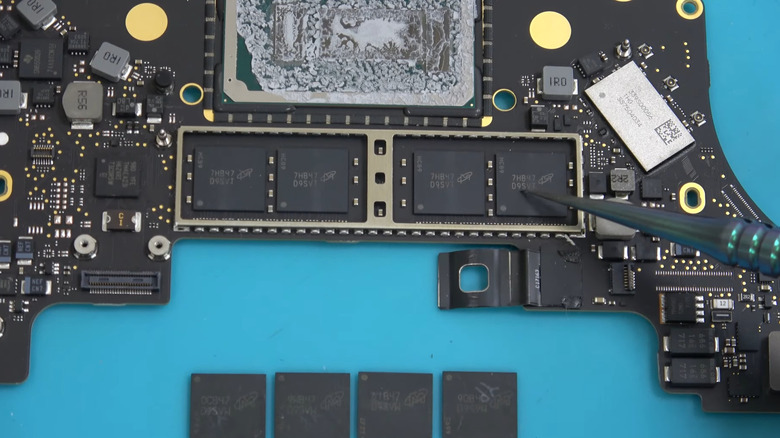What Is Soldered RAM In A Laptop And What Are The Downsides?
On average, a laptop can easily last four to five years, sometimes even longer if you take good care of it. Over time, though, you might start to notice it slowing down. In such cases, a common tip for improving performance is to upgrade the RAM (Random Access Memory), since it plays a big role in how fast your system runs. That, however, may not be an option if your laptop uses soldered RAM. So, what exactly is soldered RAM?
Soldered RAM, as you can probably guess from the name, is memory that's permanently attached to the motherboard, meaning it's not possible to remove or upgrade it. In contrast, laptops without soldered RAM usually use removable memory sticks, which makes it easy for users to swap or upgrade RAM when needed.
Soldered RAM offers several advantages. For one, since it is attached directly to the motherboard, there's no need for separate RAM slots and connectors. This saves space and allows laptops to be slimmer and lighter. A prime example of this is Apple's MacBooks, which have used soldered RAM for years. Soldered RAM can also deliver faster data transfer speeds and improved bandwidth, which is necessary for laptops built to handle AI processors. Finally, soldered RAM tends to be more durable than traditional memory sticks, since there are fewer physical components that can loosen or fail over time.
Downsides of a laptop with soldered RAM
While there are valid reasons for manufacturers to use soldered RAM in laptops, it does come with some clear downsides. The most obvious is the lack of upgradability. If your laptop has soldered memory and you ever want to upgrade or replace it, you're out of options. This is something that might not matter to the average user, but for tech-savvy users, it's a real pain point.
To make up for the lack of upgradability, you'll need to choose a model with more RAM right from the start. Another good option is a laptop that has both soldered RAM and an extra RAM slot. This will give you the flexibility to add more RAM later if needed. Essentially, soldered RAM in laptops makes it important to think ahead and future-proof your purchase.
Another downside of soldered RAM in laptops is that it makes repairing difficult and more costly. Since the RAM is permanently attached to the motherboard, a failure means replacing the entire motherboard instead of just swapping out the faulty memory. This, of course, can drive up the cost significantly. The best way to find out if a laptop uses soldered RAM is to check the manufacturer's official documentation.
Is soldered RAM in laptops a problem?
The short answer to this is no, at least not for most people. There are other important laptop components, like the CPU and GPU, that are already non-upgradeable, and soldered RAM is just another one on that list. Also, soldered RAM isn't necessarily bad as it offers benefits such as better speeds, increased reliability, and efficient use of internal space.
If you're concerned about your laptop becoming slow over time, upgrading the RAM isn't the only solution. There are ways to make Windows 11 run faster and even speed up your slow Mac by minimizing startup apps, cutting down on background processes, clearing up disk space, or switching to a high-performance power plan.
Finally, while upgrading the RAM can help, it can't magically solve everything and make your laptop last longer. If your laptop is already showing signs of wear, it might actually be smarter to replace it instead of throwing money at upgrades. Plus, you can still repurpose your old laptop for something useful like a home security hub or a game server.


